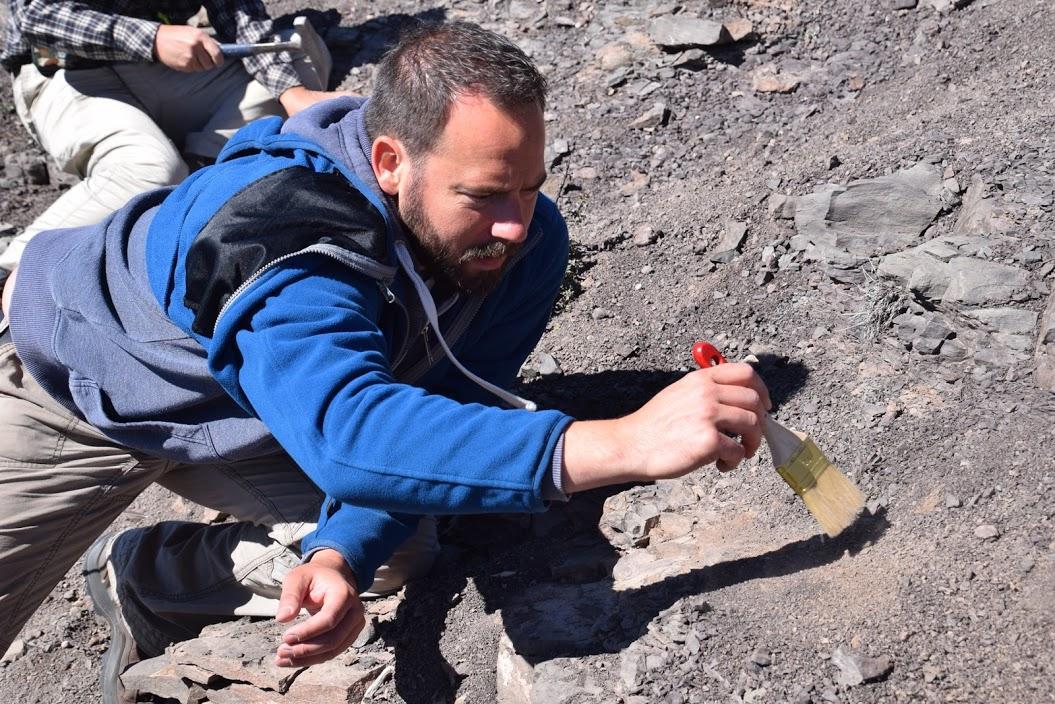Fragestellungen
Der Ursprung und die frühe Evolution der Amnioten, der Tiergruppe die alle vollständig ans Landleben angepasste Wirbeltiere beinhaltet, führte zu komplexen Veränderungen in der Struktur und Hierarchie von terrestrischen Ökosystemen. Speziell ermöglichte die Anpassung von Wirbeltieren an das Leben an Land die Evolution von spezialisierten Pflanzenfressern, neuen Fortbewegungsarten wie beispielsweise des Kletterns und Fliegens, sowie die Evolution moderner Strukturen terrestrischer Ökosysteme. Meine Forschung untersucht die Verwandtschaftsverhältnisse, Paläobiologie und Diversifikationsmuster innerhalb der frühen Amnioten, mit speziellem Fokus auf den Synapsiden, die letztendlich auch zur Evolution der Säugetiere geführt haben. Mit meiner Forschungsarbeit kombiniere ich paläontologische Geländearbeit mit modernen Methoden (z. B. 3D-Bildtechnologien) und quantitativen Arbeitsansätzen, um neue Einblicke in die frühe Diversifikation der verschiedenen Wirbeltiergruppen und die Evolution von Schlüsselinnovationen zu erhalten. Im besonderen Fokus steht die quantitative Untersuchung der Evolution von terrestrischen Ökosystemen sowie der Impakt des größten Massenaussterbeereignisses in der Erdgeschichte an der Perm-Trias-Grenze auf terrestrische Ökosysteme.
Laufzeit
Bis 2020
Finanzierung
Deutsche Forschungsgemeinschaft - DFG
Kooperationspartner
- Dr. Kenneth D. Angielczyk, The Field Museum of Natural History, Chicago, USA
- Dr. Juan C. Cisneros, Universidade Federal do Piauí, Teresina, Brazil
- Dr. Christian F. Kammerer, North Carolina Museum of Natural Sciences, Raleigh, USA
- Dr. Claudia Marsicano, Universidad de Buenos Aires, Argentina
- Prof. Emily Rayfield, University of Bristol, UK
- Prof. Robert R. Reisz, University of Toronto, Canada
- Dr. Martha Richter, Natural History Museum, London, UK
- Prof. Bruce Rubidge, University of the Witwatersrand, Johannesburg, South Africa
- Prof. Dr. P. Martin Sander, Rheinische Friedrich-Wilhems-Universität Bonn
- Prof. Dr. Lars Schmitz, W.M. Keck Science Department, Claremont, USA
- Dr. Roger M. H. Smith, Iziko, The South African Museum, South Africa
Ausgewählte Publikationen
- Romano, M., Brocklehurst, N., and Fröbisch, J. (2017) Discrete and continuous character-based disparity analyses converge to the same macroevolutionary signal: a case study from captorhinids. – Scientific Reports 7: 17531.
- Brocklehurst, N., Day, M. O., Rubidge, B. S., and Fröbisch, J. (2017) Olson’s Extinction and the latitudinal biodiversity gradient of tetrapods in the Permian. – Proceedings of the Royal Society B 284: 20170231.
- Verrière, A., Brocklehurst, N., and Fröbisch, J. (2016) Assessing the completeness of the fossil record: comparison of different methods applied to parareptiles (Tetrapoda, Sauropsida). – Paleobiology 42 (4): 680–695.
- Brocklehurst, N., Ruta, M., Müller, J., and Fröbisch, J. (2015) Elevated extinction rates as a trigger for diversification rate shifts: early amniotes as a case study. – Scientific Reports 5: 17104.
- Cisneros, J. C., Marsicano, C., Angielczyk, K. D., Smith, R. M. H., Richter, M., Fröbisch, J., Kammerer, C. F., and Sadleir, R. (2015) New Permian fauna from tropical Gondwana. – Nature Communications 6: 8676.
- C. F. Kammerer, K. D. Angielczyk, and J. Fröbisch (2014) Early Evolutionary History of the Synapsida. Berlin/Heidelberg (Springer): 337 pp.
- Reisz, R. R. and Fröbisch, J. (2014) The oldest caseid synapsid from the late Pennsylvanian of Kansas, and the evolution of herbivory in terrestrial vertebrates. – PLoS ONE 9 (4): e94518.
- Fröbisch, J. (2013) Vertebrate diversity across the end-Permian extinction – separating biological and geological signals. – Palaeogeography, Palaeoclimatology, Palaeoecology 372: 50-61.
- Fröbisch, N. B., Fröbisch, J., Sander, P. M., Schmitz, L., and Rieppel, O. (2013) A Middle Triassic macropredatory ichthyosaur and the origin of modern trophic networks. – Proceedings of the National Academy of Sciences of the United States of America 110 (4): 1393–1397.
- Kammerer, C. F., Angielczyk, K. D., and Fröbisch, J. (2011) A comprehensive taxonomic revision of Dicynodon (Therapsida: Anomodontia) and its implications for dicynodont phylogeny, biogeography, and biostratigraphy. – Journal of Vertebrate Paleontology, Memoir 31(S1): 1-157.
- Fröbisch, J., Angielczyk, K. D., and Sidor, C. A. (2010) The Triassic dicynodont Kombuisia (Synapsida, Anomodontia) from Antarctica, a refuge from the terrestrial Permian-Triassic mass extinction. – Naturwissenschaften 97: 187-196.
- Fröbisch, J. and Reisz, R. R. (2009) The Late Permian herbivore Suminia and the early evolution of arboreality in terrestrial vertebrate ecosystems. – Proceedings of the Royal Society B 276: 3611-3618.
- Fröbisch, J. (2009) Composition and similarity of global anomodont-bearing tetrapod faunas. – Earth-Science Reviews 95 (3-4): 119-157.
- Fröbisch, J. (2008) Global taxonomic diversity of anomodonts (Tetrapoda, Therapsida) and the terrestrial rock record across the Permian-Triassic boundary. – PLoS ONE 3 (11): e3733.
